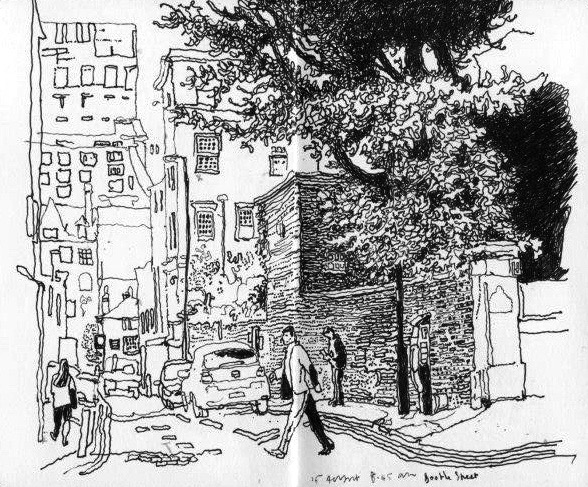This week we invited local artist and regular visitor of the gallery, John W Hewitt, to explain his experiences of Manchester Art Gallery as a source of inspiration for his art work. Hewitt's urban drawings document and reflect on the diverse landscape of our city, highlighting the sites and scenes we may often take for granted.
“I have been making daily observational sketchbook drawings since 2nd June 2013. Their content often arises as I walk from Victoria or Piccadilly Station to All Saints and back. These are repeated routes with frequent detours, short-cuts and excursions. My Manchester drawings can be divided into categories including radical history, the art school, street traders, birds’ nests, cultural and historic landmarks and events, travel and communication, the weather, the seasons, work and homelessness. During the period of making these drawings Manchester has been undergoing considerable structural regeneration, while some of its inhabitants have visibly suffered from a spiral of social degeneration. There is often an architectural aspect to the images, but they are primarily driven by human narratives, whether it is those of historically celebrated Mancunians such as Thomas De Quincy or those of present-day citizens who bed down on the city’s benches and shop doorways.












Manchester Art Gallery and its environs are significant landmarks on my urban walks. The Gallery’s proximity to the library, the town Hall, the convention centre and public open spaces provides a relatively calm place for reflection, observation and study. The Gallery itself is always a delight to visit. Its rooms are airy without being clinical, and spacious without being overwhelming. It invariably hosts student groups of all ages, and feels as welcoming a place to make art as it is to see art. The permanent collection provides invaluable insights into the evolution of creative thinking. One of my favourite paintings is William Holman Hunt’s The Hireling Shepherd, with its package of symbols and subtexts naturalistically cloaked by an initial appearance of rustic romanticism. Acutely observed details such as fleeting swallows and swifts, or the shadows of the shepherd’s eyelashes on his cheek, bring me back to this painting every time I visit the gallery. Although its moral messages may not immediately resonate today, the evidence of the artist’s eye remains as vital as when the work was first painted. Recent temporary exhibitions that I have particularly admired include The Sensory War and True Faith, though all the shows I have seen here have been inviting and expansive, intelligently balancing serious scholarship with the pleasures and challenges of looking.
William Holman Hunt The Hireling Shepherd 1851 © Manchester City Galleries
“In my role as a part-time lecturer in Illustration with Animation at Manchester School of Art there are times in the academic calendar when I accompany groups of students to the Gallery. Our entire first year is introduced to the collections through a one-day drawing exercise during their first week on the course. It is hoped that this short but intense encounter will engender lasting interest in the gallery’s exhibits and resources. I take smaller groups of first year students on a location drawing project in and around St Peter’s Square. There is a strong psychogeographic element to this brief, and students are asked to consider site-specific events including the Peterloo Massacre, the actions of suffragettes, performances by Bob Dylan and the Sex Pistols, and how waves of construction, demolition and redevelopment have shaped the local demographic and built environment. This project has sometimes coincided with the carnival of a political party conference, which is a gift for illustrators and triggers useful comparisons between the methods of the pen and the camera.
My practice of doing a daily sketch began as a counterpoint to working on drawings that took months to complete. I have enjoyed several periods where the sketchbook has been a primary format. I was an on-tour sketch artist with the London-Irish group The Pogues during late 1980s and have done reportage drawings for several national newspapers and magazines. I was caught up in the London bombings of July 2005 and recorded what I saw in 59 drawings made from memory, the next day, which are now in the Museum of London. Memory has played an important part in my image-making and I completed a PhD on the evidential value of memory in reportage drawing, in 2008. I believe that every observational drawing has aspects of memory running through it, and memory is active in my processes of daily drawing. Perhaps the interplay of memory is one of the qualities that differentiates observational drawing from photography. At a further remove from the lens, many of my personal concerns with location, history and chance encounters correspond with longstanding literary traditions of urban wandering. I often recognise an equivalence between drawing and handwriting in the activity of delineating experiences of places and events.
My daily drawings are part exercise, part journal and part enquiry. The need to get a drawing done, amongst other tasks, pressures me to select a topic early and to draw quickly. If time allows I will return to a location later in the day, but the daily turnover means that no image is developed to a ‘finished’ point. Clumsy draughtsmanship cannot be erased but remains as a relic of the conditions of drawing.
In my Manchester drawings I am not aiming to create a balanced visual survey of the city’s lives, histories and cultures. My relationship with Manchester dates from the 1960s but is essentially fragmentary. I come and I go. My absences are long enough to sustain a sense of extraordinariness about the city that cuts through the familiarity of the corridor of the walk to work.
I draw with an 0.5 gel pen in sketchbooks that measure 14 by 18 centimetres when open. The drawings are dated and timed and have appeared on Instagram each day since June 2015, with short contextual commentaries. At present I have completed 54 sketchbooks and over 2000 consecutive daily drawings.”
Find w_john_hewitt on instagram

